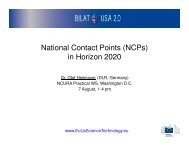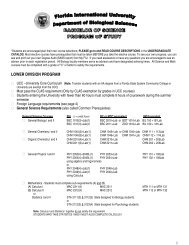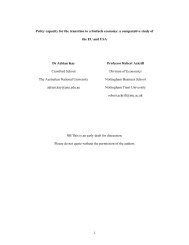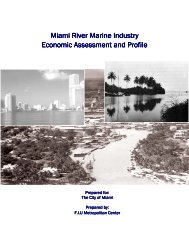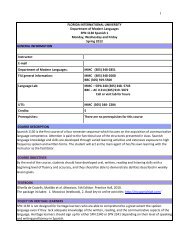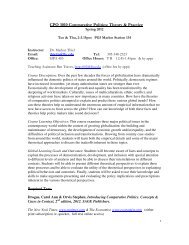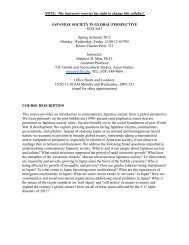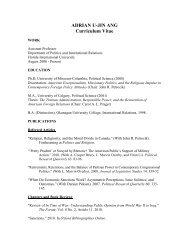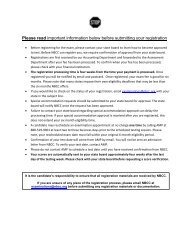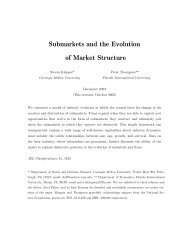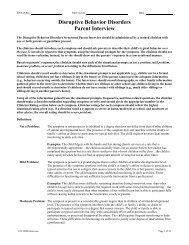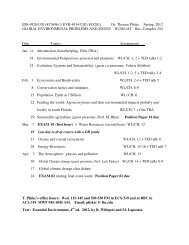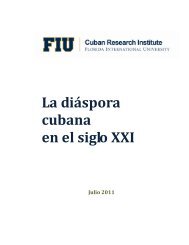Second Annual IFRI Forensic Science Symposium - College of Arts ...
Second Annual IFRI Forensic Science Symposium - College of Arts ...
Second Annual IFRI Forensic Science Symposium - College of Arts ...
Create successful ePaper yourself
Turn your PDF publications into a flip-book with our unique Google optimized e-Paper software.
<strong>Second</strong> <strong>Annual</strong> <strong>IFRI</strong> <strong>Forensic</strong> <strong>Science</strong> <strong>Symposium</strong> • March 13 - 14, 2013<br />
23. Cutting Out the Middle (Wo)Man: Implementing a Direct Outsourcing Strategy for DNA Cases<br />
Celynda Sowards, Palm Beach Sheriff’s Office<br />
The Palm Beach County Sheriff’s Office <strong>Forensic</strong> Biology Unit (FBU) has been outsourcing DNA evidence from property crimes since 2003. In September<br />
<strong>of</strong> 2012 the FBU introduced the Direct DNA Initiative as a means to bypass the FBU in the evidence submission process to the vendor DNA laboratory.<br />
Traditionally a law enforcement agency (LEA) submitted evidence to the PBSO Evidence Unit where the FBU would then take custody. The evidence<br />
was catalogued on a manifest, packed into shipping containers and overnight expressed to the vendor by the FBU. When the cases were complete,<br />
the entire process was reversed. All hardcopy and electronic data and reports generated at the vendor laboratory were submitted to the FBU for review.<br />
Following review <strong>of</strong> the data, qualifying DNA pr<strong>of</strong>iles were entered into CODIS. Regardless if a DNA pr<strong>of</strong>ile was obtained, an FBU report was generated<br />
for each case and distributed to the appropriate law enforcement agency contact. Hundreds <strong>of</strong> cases a year underwent this technical and administrative<br />
process, draining resources. Through the Direct DNA Initiative the vendor laboratory interacts directly with the LEA’s, eliminating the FBU from all but<br />
the review <strong>of</strong> cases in which potential qualifying DNA pr<strong>of</strong>iles may be uploaded to CODIS. Considering a significant portion <strong>of</strong> the samples are negative<br />
for the detection <strong>of</strong> DNA, pr<strong>of</strong>iles match the victim or elimination standards or partial pr<strong>of</strong>iles are generated and are not <strong>of</strong> CODIS quality, the process<br />
is substantially more efficient. The goals <strong>of</strong> this Initiative include allowing LEA’s to have ownership <strong>of</strong> their cases, returning DNA results to LEA’s more<br />
quickly, decreasing the FBU’s backlog while also saving time technically and administratively. The process <strong>of</strong> developing the Initiative, LEA buy-in,<br />
logistics and initial results will be discussed.<br />
24. Divide And Conquer: A Novel Approach To Tackling A Growing Dna Backlog And Increasing Turnaround Times<br />
Angela Spessard, Palm Beach County Sheriff’s Office<br />
The Palm Beach County Sheriff’s Office <strong>Forensic</strong> Biology Unit (FBU) is the only DNA forensic service provider for all law enforcement agencies within<br />
Palm Beach County. Despite continuing National Institute <strong>of</strong> Justice (NIJ) grant funding to increase efficiency and decrease the backlog, the FBU was still<br />
experiencing a growing backlog and increasing case report turnaround times. In 2009, grant monies from the NIJ Efficiency Improvement Program were<br />
requested to construct a central Biology Processing Laboratory (BPL) in an existing space within the Boca Raton Police Services Department. The BPL<br />
would serve southern Palm Beach County law enforcement agencies as a screening laboratory, processing evidence for the confirmation <strong>of</strong> blood and<br />
semen and swabbing evidence items for DNA. All informative evidence would then be submitted to the FBU for DNA analysis. The BPL opened its doors<br />
in April 2012 and functions in collaboration with the FBU. A dual laboratory perspective on the challenges, changes, and initial results <strong>of</strong> the collaboration<br />
will be presented which illustrate how the BPL and FBU have grown together to handle case management and flow.<br />
25. The ABC’s <strong>of</strong> <strong>Forensic</strong> Certification<br />
Angie Vassalotti, Palm Beach County Sheriff’s Office<br />
In response to the 2009 National Academy <strong>of</strong> <strong>Science</strong>s Report recommendation, there has been a slow trend to certify forensic pr<strong>of</strong>essionals. Certification<br />
is currently a voluntary process through which a practitioner can be recognized for attaining the pr<strong>of</strong>essional qualifications necessary to practice in one<br />
or more disciplines <strong>of</strong> criminalistics. While multiple accredited certification bodies exist for other forensic disciplines such as toxicology, latent prints,<br />
and firearms, the American Board <strong>of</strong> Criminalistics (ABC) is the only organization that is accredited to <strong>of</strong>fer certification to DNA analysts through their<br />
Molecular Biology examination. In 2009 it became the goal <strong>of</strong> the Palm Beach County Sheriff’s Office <strong>Forensic</strong> Biology Unit (FBU) to certify all <strong>of</strong> its DNA<br />
analysts. In 2012, after three phases <strong>of</strong> testing, the FBU achieved ABC certification <strong>of</strong> thirteen staff members, becoming the first DNA laboratory in the<br />
state <strong>of</strong> Florida to have 100% <strong>of</strong> qualified DNA analysts certified.<br />
26. Spatial autocorrelation <strong>of</strong> soil biota pr<strong>of</strong>iles with soil type can be used for soil provenance.<br />
Natalie Damaso, Maria Mendoza and DeEtta Mills, International <strong>Forensic</strong> Research Institute<br />
Background: A common ecological hypothesis is that soil type (i.e., chemical/physical properties) drives which microbes occupy a particular soil.<br />
Therefore, soil metagenome pr<strong>of</strong>iling should be able to produce a unique biotic pr<strong>of</strong>ile and subsequent DNA analyses <strong>of</strong> the microbial community<br />
can enable a rapid method for soil provenance. Objective: Spatial autocorrelation analysis was used to test the assumption that geographic location<br />
and metagenomic content are linked. Method: Bacteria, archaea, fungi, and plant DNA universal markers were PCR amplified separated by capillary<br />
electrophoresis and queried across six soil types in Miami-Dade County, FL. Autocorrelations were conducted using Mantel test and R programming<br />
language. Significance: Autocorrelations linked metagenomic content to soil type, to specific transects, and could even discriminate at subplot level with<br />
strong accuracy. Seasonal changes (rain) did lessen the correlation at some sites. Significance: Spatial autocorrelation was observed and metagenomic<br />
biotic pr<strong>of</strong>iles could be used for provenance <strong>of</strong> soil evidence.<br />
Hosted by Florida International University | 15



